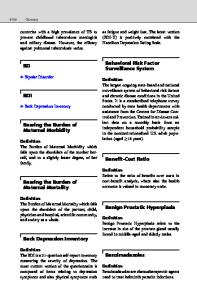Are fast food restaurants an environmental risk factor for obesity?
- PDF / 196,107 Bytes
- 6 Pages / 610 x 792 pts Page_size
- 78 Downloads / 225 Views
BioMed Central
Open Access
Research
Are fast food restaurants an environmental risk factor for obesity? Robert W Jeffery*1, Judy Baxter1, Maureen McGuire2 and Jennifer Linde1 Address: 1Division of Epidemiology & Community Health, University of Minnesota School of Public Health, 1300 South 2nd Street, Suite 300, Minneapolis, MN 55454-1015, USA and 2Guidant Corporation, Cardiac Rhythm Management Group, 4100 Hamline Ave., St. Paul, MN 55112, USA Email: Robert W Jeffery* - [email protected]; Judy Baxter - [email protected]; Maureen McGuire - [email protected]; Jennifer Linde - [email protected] * Corresponding author
Published: 25 January 2006 International Journal of Behavioral Nutrition and Physical Activity 2006, 3:2
doi:10.1186/1479-5868-3-2
Received: 8 June 2005 Accepted: 25 January 2006
This article is available from: http://www.ijbnpa.org/content/3/1/2 © 2006 Jeffery et al; licensee BioMed Central Ltd. This is an Open Access article distributed under the terms of the Creative Commons Attribution License (http://creativecommons.org/licenses/by/2.0), which permits unrestricted use, distribution, and reproduction in any medium, provided the original work is properly cited.
Abstract Objective: Eating at "fast food" restaurants has increased and is linked to obesity. This study examined whether living or working near "fast food" restaurants is associated with body weight. Methods: A telephone survey of 1033 Minnesota residents assessed body height and weight, frequency of eating at restaurants, and work and home addresses. Proximity of home and work to restaurants was assessed by Global Index System (GIS) methodology. Results: Eating at "fast food" restaurants was positively associated with having children, a high fat diet and Body Mass Index (BMI). It was negatively associated with vegetable consumption and physical activity. Proximity of "fast food" restaurants to home or work was not associated with eating at "fast food" restaurants or with BMI. Proximity of "non-fast food" restaurants was not associated with BMI, but was associated with frequency of eating at those restaurants. Conclusion: Failure to find relationships between proximity to "fast food" restaurants and obesity may be due to methodological weaknesses, e.g. the operational definition of "fast food" or "proximity", or homogeneity of restaurant proximity. Alternatively, the proliferation of "fast food" restaurants may not be a strong unique cause of obesity.
Introduction Rapid increases in the prevalence of obesity in the US over the last 20 to 30 years have been well documented and their causes much discussed [1-4]. Because of the speed of the change, it has been argued that the cause is more likely to be environmental change, broadly conceptualized to include physical and social factors, than to biological change. Exploration of data on environmental trends has identified a variety of potential environmental contributors. One trend that has attracted particular attention in both the scientific and lay press is the dramatic incre
Data Loading...











